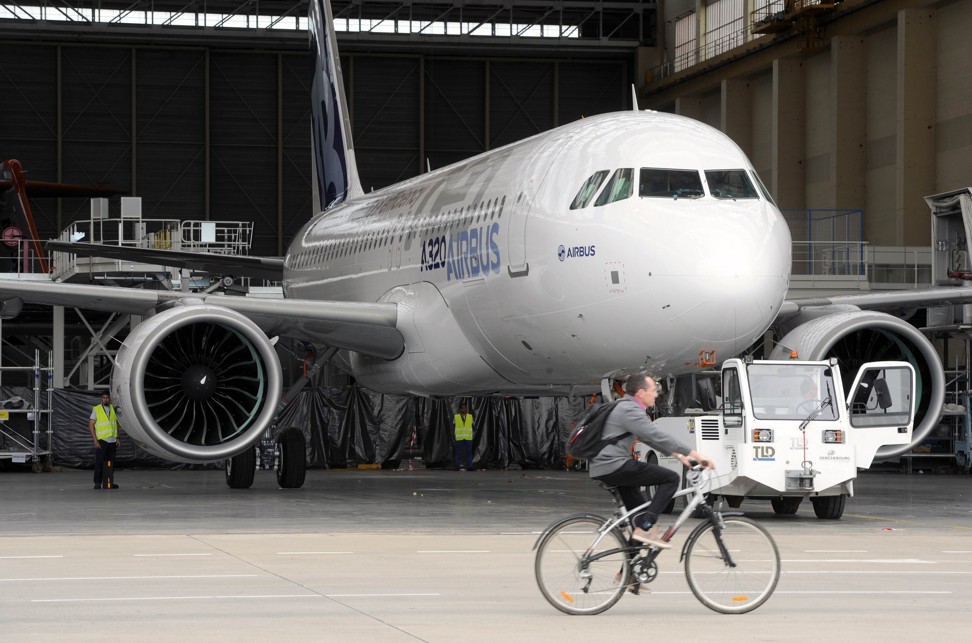China’s biggest low-cost carrier says new routes are frustrated by delivery delays of the A320neo model of its workhorse aircraft
- Spring Airlines has six of the A320neo aircraft in service, with another 10 due for delivery in 2019 that could fall two short heading into 2020
- The fleet of Shanghai-based Spring comprises 86 planes of the A320 family, with another 57 on order

Spring Airlines, mainland China’s first and biggest low-cost carrier, said it is losing valuable runway slots and unable to operate new routes as planned because of delays in taking delivery of new aircraft from its sole supplier Airbus.
The problem boils down to delays in the delivery of Airbus’ A320neo jets, of which Shanghai-based Spring has six in service, while another 10 due for delivery in 2019 could fall short of two planes heading into 2020, said the carrier’s chairman Stephen Wang.
“In China, the slots are very difficult to get,” Wang said in an interview during the CAPA Centre for Aviation CEO summit in Seoul. “When we apply [for the slots], we need the aircraft to fulfil [them], which is why if we cannot get the aircraft on time, we cannot keep the slots.”
Airbus officials said they would not comment on the delivery schedules of individual airlines. Still, any delay in the delivery schedule would be a closely watched figure as any disruption stretching into 2020 would add to the 5,600-plane backlog for the bestselling workhorse aircraft of the European manufacturer.
The A320neo, a single-aisle aircraft launched in 2010 with the capacity for up to 186 seats, is the latest variant of Airbus’ A320 family. Spring’s fleet comprises 86 planes of the A320 family, with another 57 on order.
“We have been told that deliveries of the A321neo next year may face even longer delays,” said Wang, whose carrier has 15 of the new variants on order.
The latest variant, with a lengthened fuselage, can fly further, up to 7,400 kilometres. Ireland’s Aer Lingus and Canada’s Air Transat are also customers of this aircraft, who are facing delivery delays this year.
“We have been told that because of engine issues and other supply chain issues, Airbus is trying to figure it out,” Wang said. “But they can’t tell us if it will be a delay of one month, or three months. We were told that the [A321neo delays] would get better next year.”
Spring, established in 2004 and borne out of a travel agency, now flies to 100 destinations in mainland China and around Asia, including Japan, Cambodia, Hong Kong and Singapore. It reported a 2018 profit of 1.5 billion yuan (US$217 million).
The airline is aiming to fly 22 million passengers in 2019, although that number could be undermined by delays in aircraft deliveries.

Still, the carrier is fully backing its sole supplier, setting its sights on the extra-long range (XLR) variant of the A321neo aircraft, which can fly 1,600 kilometres further than the long-range A321neo when it enters service in 2023. The A321neo XLR, which can seat up to 244 people, can fly for around seven hours from northern China to Southeast Asia, including Singapore and Indonesia, Wang said. The airline’s longest route currently is a five-and-half-hour flight from Shanghai to Singapore, he said. The use of an XLR variant would open up more low-cost routes as far as Southeast Asia to tourists from Beijing and other northern Chinese cities.
American Airlines, British Airways and India’s Indigo are among other carriers that have declared their interest in the XLR. The plane is seen as a rival replacement for the older generation of Boeing’s 757 aircraft, and could pre-empt the American manufacturer’s proposed new mid-size jet, the NMA, seen as an increasingly likely alternative over the much-maligned 737 MAX when it starts flying by 2025.